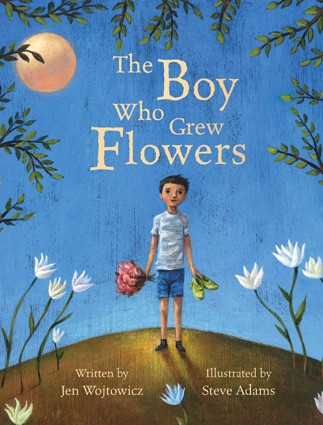Rink is a very unusual boy who grows beautiful flowers all over his body whenever the moon is full. Rink and his family are treated as outcasts even though no one knows his strange botanical secret. But one day a new girl arrives at school, and Rink discovers she has some unique qualities of her own. Illustrator Steve Adams’ rich, textured artwork gives this tale of individuality bottomless depth and appeal.ForeWord Magazine‘s Book of the Year Award Finalist. Ages 4 to 10 years.
A writer’s unexpected muse:
her brother
By Jennifer E. O’Brien, An article from the Times Union First published: Thursday, May 4, 2006
Jen Wojtowicz never set out to write a book about autism. But a close friend who read the Vischer Ferry author’s children’s book, “The Boy Who Grew Flowers” (Barefoot Books; $16.99; 32 pages), said the main character’s ability to grow flowers out of his body was a beautiful metaphor for the developmental disability that Wojtowicz’s older brother, Wally, has.
He might be different, but she knew he had a goodness inside, even if other people might not take the time to recognize it. And while her brother’s disability influenced many parts of her life, she didn’t know how deeply it touched her before the book.
“I think those kinds of things get worked out inside of us without us even knowing,” says Wojtowicz.
Wojtowicz’s book, illustrated by Steve Adams, that sensitively tells the story of Rink Bowagon, a young boy and misfit, who along with his unusual family (Uncle Dud tames rattlesnakes) lives atop Lonesome Mountain.
Ignored by the other students and his teacher, Rink lives a rather isolated existence. When a new student, Angelina Quiz from Tuscaloosa, moves to town, Rink decides that he likes “her straight away.” It is through Angelina’s presence and the announcement of an upcoming school dance that Rink is brave enough to make a new friend and let his kindness shine.
Rink’s feelings of alienation were familiar to the author. Wojtowicz remembers her older sister coming home from school in tears because she had been teased about having a brother who was so different. While she was horrified to see her sister so upset, she recalls “deciding at a very young age to never be embarrassed by my brother.”
This is not to say that she wasn’t fiercely protective of him. Wojtowicz said she perfected the “stare down,” used on strangers who might have considered saying something unkind, and recalls beating up another child who called him a “retard.”
Autism is a developmental disorder that can impair social interaction and cause difficulties in communicating, seeing and hearing. In addition to problems communicating, Wally Wojtowicz’s disability also caused him to have seizures in the night. Jen Wojtowicz remembers waking up with him, singing to him and comforting him.
Growing up with Wally allowed the author to observe all the positive qualities “different” people have to offer, which eventually led her to her career. While job hunting after graduating from college, Wojtowicz’s parents suggested she consider working with people with disabilities. At that point, she recalls thinking, “I can run away from this or embrace it. I prefer to work in a field that is making someone else’s life better.” Wojtowicz is an art teacher with Living Resources, a human service agency for people with disabilities, where she has been employed for the past 13 years.
In her book, she reflects what she’s learned from her students, that disabled people have their own strengths and talents.
“People with disabilities are not excluded, by any means, from the full range of emotions and life connections with others,” she says. “I think it is mostly when ‘normal’ people are calling the shots and trying to make decisions they kind of fail to see that.”
In the story, Rink fashions special shoes for Angelina crafted out of snake skin and leather to wear to the dance. Rink’s efforts are enthusiastically received by Angelina, whose right leg is shorter than her left by an inch. For the first time in her life, she stands up straight and then does a little dance. After attending the dance together, Angelina and Rink become fast friends.
Wojtowicz will address elementary educators at a special breakfast Saturday at Barnes and Noble on Wolf Road in Colonie. She wants teachers to see her book as a way to begin discussions in their classrooms. Along with talking about what makes people different, Wojtowicz suggests teachers ask students to identify the different, specific qualities of Rink and Angelina. As with any good tale, there’s a lesson here, too.
“Rink shared information with Angelina that he felt very fearful of revealing, and she shares something with him likewise. … It cemented their friendship; they had acceptance for each other. Because they were capable of being good friends they knew what to do with sensitive information,” she says.
While she didn’t intend to, Wojtowicz is clearly able to share the valuable information and lessons she has learned from growing up with her brother. In the end, she feels that he is the best person in her family — the one who has helped shape them all.
“Without him, how we would be the people that we are, if we hadn’t been given that opportunity to love someone unconditionally,” she says. “It’s been a remarkable window to see that other people have other ways of going about their life that are as valuable and valid as a normal person.”
~
Jennifer O’Brien is a freelance writer living in Albany.
All Times Union materials copyright 1996-2006, Capital Newspapers Division of The Hearst Corporation, Albany, N.Y.
In May of 2011 the talented students and teachers of Abraham Lincoln Elementary in Madison, Wisconsin featured The Boy Who Grew Flowers in their wonderful video about the magic of reading called Carried Away.
As well as being distibuted in England and the U.S. The Boy Who Grew Flowers has been published in Korean, Catalan, Spanish, Greek, Brazilian Portugese, and French Canadian. I was contacted by some school teachers from Brazil who developed the book into a play for their classroom, as a part of their curriculum.
The Boy Who Grew Flowers was featured as a future classic on Oprah.com’s list of 2 Unforgettable Books Every Child Should Read, Plus 5 Future Classics.
The WITS website has a very nice classroom lesson based around The Boy Who Grew Flowers. “The WITS Programs bring together schools, families and communities to create responsive environments that help elementary school children deal with bullying and peer victimization. The links on this page provide everything you need to get started with the WITS Programs.” Nice!
In 2019 The Treehouse Shakers adapted The Boy who Grew Flowers into a beautiful play, featuring dance and puppets! I was fortunate to see the production at The Egg in Albany NY and I was delighted not only by the talent of the actors and dancers but by the fresh interpretation of the story. Try to see this if you can!
And finally- my favorite comment ever: “My eight year old son who has Tourette’s, takes ballet lessons and is a vegetarian (in beef farming country) often feels at odds with his peers. He selected this book for his school book report because it “makes him feel mushy” and he likes how the boy “finds someone who loves him.” Charlie Stockalis 2006, Amazon review
I always wonder how that little boy is doing now?

